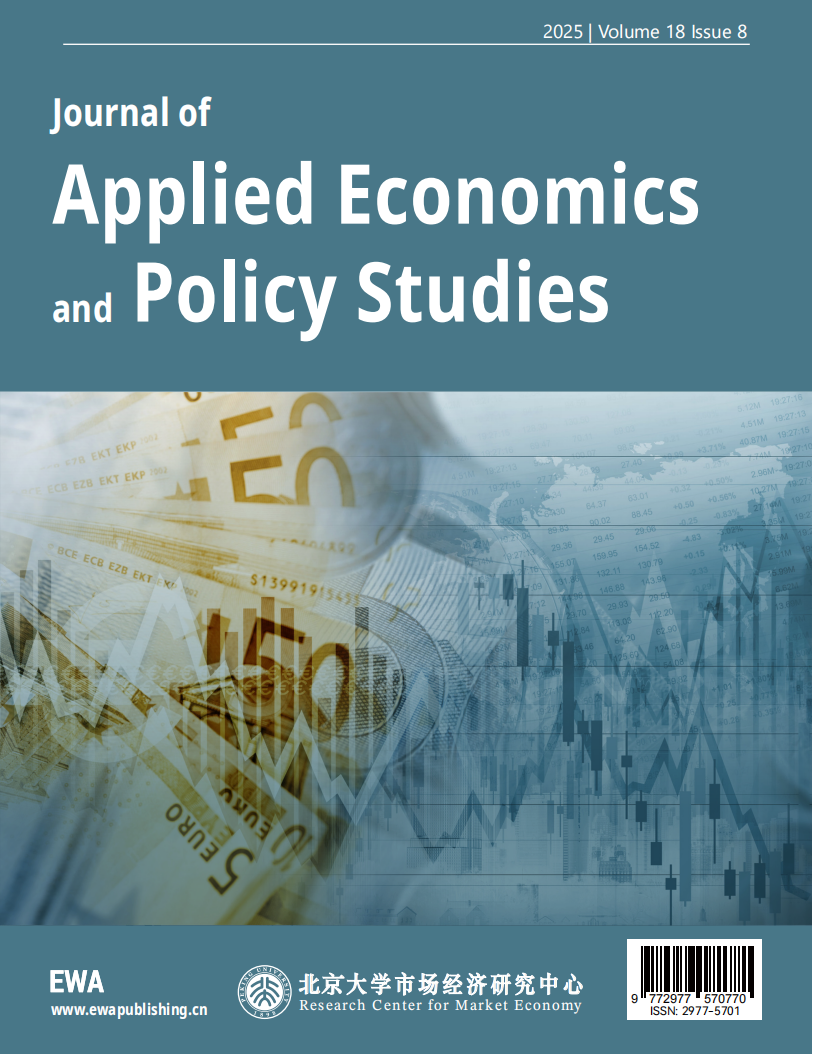1. Introduction
With the development of Internet technology, social media has become an indispensable part of people's daily lives. According to a report released by the China Internet Network Information Center (CNNIC), as of January 2025, the number of Internet users in China had reached nearly 1.108 billion, with an Internet penetration rate rising to 78.6%. The widespread application of social media has not only transformed patterns of social interaction but has also profoundly reshaped the business marketing ecosystem. Increasingly, enterprises are adopting social media as their primary marketing channel, leveraging these platforms to launch a wide range of marketing content, such as short videos and graphic posts. These forms of marketing—characterized by strong interactivity and personalized appeal—exert significant influence on consumers' purchasing behavior. Undergraduate students are both intensive users of social media and an emerging force in social media consumption, possessing high consumption potential and strong consumption awareness. Beijing, as one of China's major hubs for higher education, has a large undergraduate population and considerable consumer market potential. Therefore, from the perspective of consumption behavior among undergraduate students in Beijing, studying the factors influencing their purchase intention in the context of social media is of great significance for understanding the consumption patterns of young consumer groups and tapping into the social media market. At present, numerous domestic and international scholars have conducted studies on consumer behavior in social media contexts. Some research has revealed that the entertainment value and professionalism of social media marketing content have a positive effect on consumer behavior; other studies have identified that certain traits and attitudes influence consumer purchase behavior [1]. Moreover, scholars have found that subjective norms, social media engagement, and self-control also exert an impact on purchase behavior [2]. However, most of these studies have focused on a broad consumer base, and the identified influencing factors lack representativeness for young consumers as a specific group. In light of this, it is highly meaningful to investigate, from the perspective of undergraduate students in Beijing, the factors influencing their purchase intention in the context of social media. This study focuses specifically on this cohort, examining in depth the factors affecting their purchase intention in a social media marketing environment. By employing questionnaire surveys and online data collection, and quantifying the collected data for correlation analysis, this study explores how social media marketing content influences their purchase intention. The findings can provide a basis both for cultivating better consumption concepts among consumers and for enabling enterprises to formulate more effective marketing strategies.
2. Research design
2.1. Research methods
In terms of data collection, this study adopts both questionnaire surveys and social media data collection. The questionnaire survey focuses on the undergraduate student population in Beijing, directly obtaining key data related to their consumption behavior, mental health, and other relevant factors. The questionnaires were distributed through online promotion and publicity via social media comments. The collected questionnaire data were then compiled, invalid responses were excluded, and certain objective items were quantified. In addition, this study also employs social media data collection methods. Using web crawler software, comments on social media platforms were retrieved. During the data collection process, the study selected several products with the highest sales among the undergraduate age group in Beijing on the Douyin platform. Product promotion video information was captured through keyword searches, and the corresponding comment content was collected. Sentiment analysis of these comments was conducted using a machine learning model.
This study employs correlation analysis and sentiment analysis. Correlation analysis enables the identification of hidden influence pathways and trends within the data, facilitating the examination of associations and the strength of relationships between different variables (such as mental health and consumption frequency), as well as providing an in-depth analysis of specific correlations. Sentiment analysis, through natural language processing and mining, extracts subjective information from textual data to identify emotional tendencies. This approach helps to understand user attitudes and the broader context, thereby assessing the social media commenting environment and its impact on consumers’ purchase intention [3].
2.2. Variable explanation and research hypotheses
Social media addiction refers to an individual's use of social media beyond a reasonable scope, manifested in behaviors such as excessive use, inability to control usage time, and withdrawal symptoms such as anxiety when disengaged from social media. Social media addiction is closely related to individual mental health factors such as depression and loneliness, and it exerts substantial negative impacts on both personal life and the broader social environment [4]. Previous studies have shown that social media can satisfy innate human needs, and that users choose to engage with social media to fulfill self-perceived rational needs. Moreover, the visual presentation mode of social media content is more effective than text in attracting users, making social media an easy "playground" for fostering user addiction [5].
The social media commenting environment refers to the overall trend of comments under video content on social media, which is jointly influenced by users, platforms, and society, and is characterized by immediacy and interactivity. Relevant research has found that the overall trend of comment content significantly affects users' behaviors and thoughts [6]. Existing studies have also demonstrated that the emotional polarity of comments can influence consumers' purchase intention [7]. Based on the above theoretical analysis, this study constructs a mediating effect model with purchase intention (Y), mental health level (M), and social media addiction (X) as variables. In this model, social media addiction (X) serves as the independent variable, purchase intention (Y) as the dependent variable, and mental health level (M) as the mediating variable. Accordingly, this study proposes the following hypotheses:
Hypothesis 1: Social media addiction influences purchase intention with mental health level as a mediating variable.
3. Research results
This study uses SPSS software to conduct correlation analysis involving the mediating variable, aiming to test whether the hypothesis that social media addiction influences purchase intention through mental health level holds true.
| Mediation analysis results (n=201) | ||||||||||||||||||
|
Y |
M |
Y |
||||||||||||||||
|
B |
SE |
t |
p |
|
B |
SE |
|
|
|
B |
SE |
|
|
|
||||
|
Constant |
0.084* |
0.037 |
2.246 |
0.026 |
- |
0.693** |
0.168 |
4.113 |
0.000 |
- |
0.023 |
0.036 |
0.651 |
0.516 |
- |
|||
|
X |
0.834** |
0.059 |
14.163 |
0.000 |
0.709 |
0.790** |
0.266 |
2.969 |
0.003 |
0.206 |
0.766** |
0.055 |
13.799 |
0.000 |
0.650 |
|||
|
M |
0.087** |
0.014 |
6.033 |
0.000 |
0.284 |
|||||||||||||
|
R 2 |
0.502 |
0.042 |
0.579 |
|||||||||||||||
|
Adjusted R² |
0.499 |
0.038 |
0.575 |
|||||||||||||||
|
F-value (Overall model significance test) |
F (1,199)=200.596, |
F (1,199)=8.817, |
F (2,198)=136.336, |
|||||||||||||||
*
As shown in Table 1, the following analysis is derived from the results:
Using purchase intention (Y) as the dependent variable and social media addiction (X) as the independent variable, a regression analysis was conducted. The results indicate that social media addiction (X) has a significant positive predictive effect on purchase intention (B = 0.834,
|
Path |
c (Total Effect) |
a (Path Coefficient X → M) |
b (Path Coefficient M → Y) |
a*b (Mediation Effect) |
a*b (Boot SE) |
a*b (z-value) |
a*b ( |
a*b (95% BootCI) |
c' (Direct Effect) |
Test Conclusion |
|
X=>M=>Y |
0.834** |
0.790** |
0.087** |
0.069 |
0.031 |
2.199 |
0.028 |
0.012 ~ 0.137 |
0.766** |
Partial Mediation |
Notes:
* p<0.05 ** p<0.01
Bootstrap type: Percentile bootstrap method
As shown in Table 2, the following analysis is drawn from the results:
First, before including the mediating variable mental health level (M), the total effect of social media addiction (X) on purchase intention (Y) is significant (c = 0.834,
Second, the effect of social media addiction (X) on the mediating variable mental health level (M) is significant (a = 0.790,
Third, the effect of mental health level (M) on purchase intention (Y) is also significant (b = 0.087,
Furthermore, the mediation effect value (a*b) was calculated. The results show a mediation effect of 0.069, with a bootstrap standard error of 0.031, a z-value of 2.199, a p-value of 0.028 (
Finally, after including the mediating variable mental health level (M), the direct effect of social media addiction (X) on purchase intention (Y) remains significant (c' = 0.766,
3.1. Correlation between social media commenting environment and purchase intention
Sentiment analysis was conducted on the comment content of several top-selling products among Beijing undergraduate students on the Douyin platform.
Product 1: Hair Dye (a total of 153 comments)
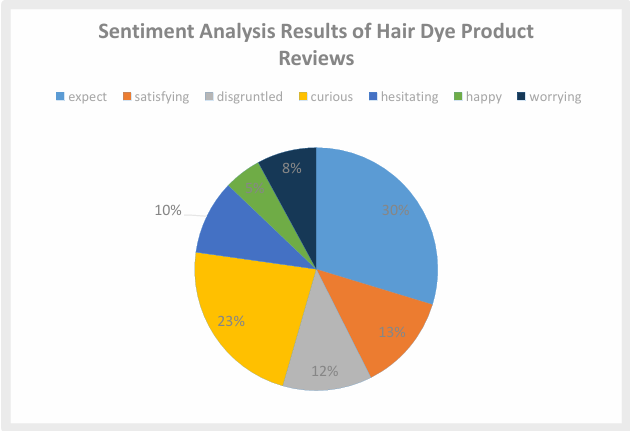
Product 2: Sanitary Pads (a total of 141 comments)
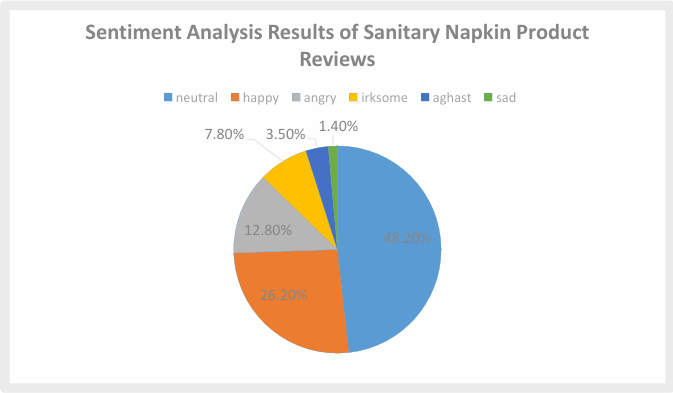
Product 3: Boneless Chicken Feet (a total of 40 comments)
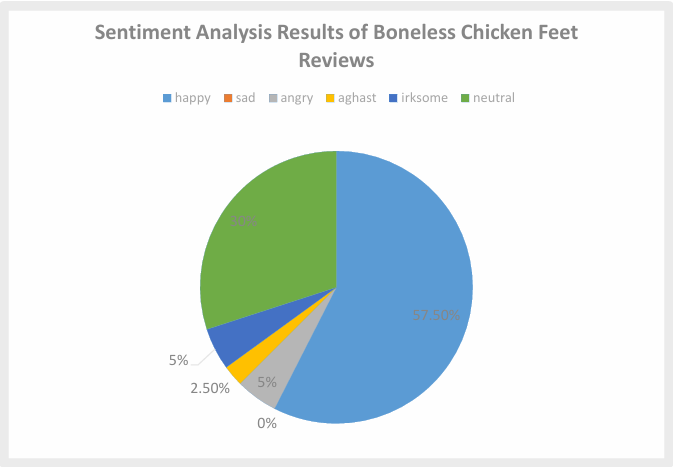
Product 4: Facial Cleanser (a total of 87 comments)
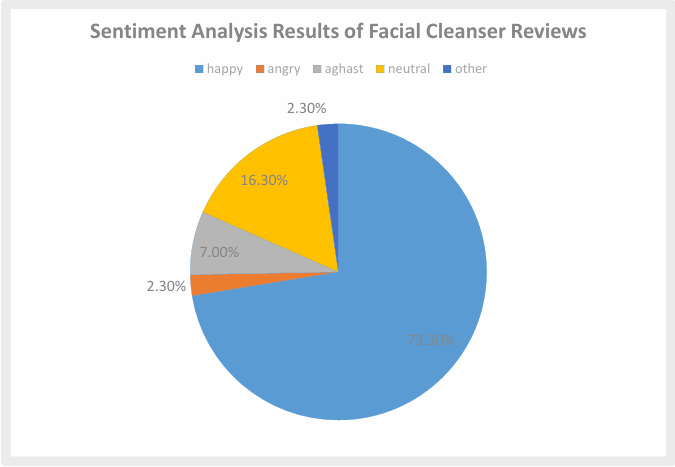
Product 5: Lip Balm (a total of 244 comments)
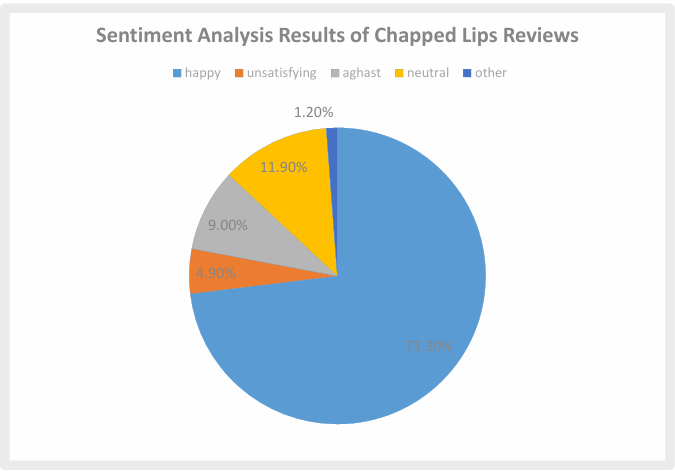
As shown in Figures 1 to 5, the following analysis is drawn from the results:
Among the five products studied, the majority of product comments are dominated by positive emotions, indicating that favorable feedback contributes to increasing the purchase intention of the user base. Meanwhile, emotions of curiosity and anticipation also constitute a significant portion, suggesting that this attitude of open exploration further promotes consumers' purchasing behavior. Moreover, the proportion of negative emotions is relatively low, indicating that the overall commenting environment is relatively positive. This positive emotional atmosphere reduces consumers' concerns and enhances their purchase intention. In summary, through sentiment analysis, this study finds that comments on high-selling products tend to be predominantly positive, and the social media commenting environment is positively correlated with purchase intention.
4. Discussion
This study focuses on the perspective of undergraduate students in Beijing and examines the intrinsic relationships among their mental health level, social media addiction, and purchase intention. It finds that mental health level partially mediates the effect of social media addiction on purchase intention. Simply put, the purchase intention of undergraduates becomes stronger as their social media addiction increases, and this effect occurs indirectly through the impact of social media addiction on mental health. This finding is not without basis. Previous research has shown that social media acts as a source of stress, providing users with numerous functions that may trigger anxiety related to social approval and fear of missing out. Meanwhile, the uneven quality of information on these platforms further exacerbates stress [8]. This study found that a considerable portion of the target group experiences anxiety and unease when distanced from social media, which greatly affects their mental health.
This study also examined several best-selling products on the Douyin platform among Beijing undergraduate students and found that the comment content on the product promotion videos tended to be predominantly positive, which greatly enhanced the purchase intention of the target users. This hypothesis is also theoretically supported. According to social cognitive theory, human behavior is determined by the interaction among personal behavior, cognition, and the external environment in which the individual exists. In other words, individuals are both creators and products of their environment. Therefore, an individual's purchase intention, as a subjective idea, is influenced by the commenting environment. When this subjective intention is translated into action, it also participates in shaping the environment, which in turn continues to influence the purchase intentions of oneself and others [9].
However, this study has certain limitations. First, regarding theoretical application, although this study referenced social cognitive theory to provide some theoretical support for the proposed hypotheses, the content of these theories is extensive and complex, so the understanding and application of these theories in this research may not be sufficiently deep or detailed. Second, concerning the research hypotheses, this study only considered mental health level as a mediating variable in the pathway from social media addiction to purchase intention. In fact, many other factors also influence this pathway, such as personality traits, materialism, and social comparison [10]. Therefore, to achieve a more comprehensive and detailed understanding of the influencing mechanisms, further in-depth experiments and studies are necessary.
This study confirms that the influence of social media on the purchase intention of undergraduate students in Beijing arises from multiple factors, all of which can be affected by agents such as society, schools, and individuals. Therefore, the study recommends that social media platforms establish more comprehensive algorithmic recommendation mechanisms to prevent excessive addiction behaviors. At the same time, platforms should formulate healthy content regulations that encourage the promotion of positive and constructive content to improve users' mental health levels. Additionally, the study suggests that schools appropriately implement preventive activities targeting students’ social media addiction. Meanwhile, undergraduate students themselves should cultivate rational awareness and strengthen their self-management in social media use.
5. Conclusion
This study finds that the influence of social media on the purchase intention of undergraduate students in Beijing is multifaceted. It includes the mediating effect of mental health level on the relationship between social media addiction and purchase intention, as well as the positive impact of the social media commenting environment on purchase intention. Through questionnaire surveys and social media data collection, combined with correlation analysis and sentiment analysis, this study demonstrates that social media addiction influences purchase intention through mental health level as a mediator, and that the social media commenting environment is positively correlated with purchase intention. Based on these findings, the study recommends that enterprises strengthen the management of social media comments and promptly address negative feedback to enhance consumers' purchase intention. At the same time, individuals should control their social media addiction behaviors, reduce social media usage frequency, and effectively manage their personal consumption behaviors.
References
[1]. Kim, J., Kim, M., & Lee, S. M. (2025). Unlocking trust dynamics: An exploration of playfulness, expertise, and consumer behavior in virtual influencer marketing.International Journal of Human-Computer Interaction, 41(1), 378–390.
[2]. Masuda, H., Han, S. H., & Lee, J. (2021). Impacts of influencer attributes on purchase intentions in social media influencer marketing: Mediating roles of characterizations.Technological Forecasting and Social Change, 174, Article 121185.
[3]. Nekmahmud, M., Naz, F., Ramkissoon, H., et al. (2022). Transforming consumers' intention to purchase green products: Role of social media.Technological Forecasting and Social Change, 185, Article 122071.
[4]. Jiang, H., Cheng, Y., Yang, J., et al. (2022). AI-powered chatbot communication with customers: Dialogic interactions, satisfaction, engagement, and customer behavior.Computers in Human Behavior, 134, Article 107311.
[5]. Nythinen, J., Sirola, A., Koskelainen, T., et al. (2024). Online antecedents for young consumers’ impulse buying behavior.Computers in Human Behavior, 153, Article 107002.
[6]. Wankhade, M., Chandra Sekhara Rao, A., & Kulkarni, C. (2022). A survey on sentiment analysis methods, applications, and challenges.Artificial Intelligence Review, 55, 5731–5780.
[7]. Stanculescu, E., & Griffiths, M. D. (2022). Social media addiction profiles and their antecedents using latent profile analysis: The contribution of social anxiety, gender, and age.Telematics and Informatics, 74, Article 101905.
[8]. Meng, S., & Leung, L. (2021). Factors influencing TikTok engagement behaviors in China: An examination of gratifications sought, narcissism, and the Big Five personality traits.Telecommunications Policy, 45(7), Article 102164.
[9]. Vandenbosch, L., Fardouly, J., & Tiggemann, M. (2022). Social media and body image: Recent trends and future directions.Current Opinion in Psychology, 45, 101290.
[10]. Zafar, A. U., Qiu, J. N., Li, Y., et al. (2021). The impact of social media celebrities' posts and contextual interactions on impulse buying in social commerce.Computers in Human Behavior, 115, Article 106622.
[11]. Wolfers, L. N. N., & Utz, S. (2022). Social media use, stress, and coping.Current Opinion in Psychology, 45, 101292.
[12]. Milakovic, I. K. (2021). Purchase experience during the COVID-19 pandemic and social cognitive theory: The relevance of consumer vulnerability, resilience, and adaptability for purchase satisfaction and repurchase.International Journal of Consumer Studies, 45(6), 1425–1442.
[13]. Karsli, G. (2024). The role of technological addictions and personality traits on online compulsive buying. Izmir Katip Celebi University.
[14]. Mundel, J., Wan, A., & Yang, J. (2024). Processes underlying social comparison with influencers and subsequent impulsive buying: The roles of social anxiety and social media addiction.Journal of Marketing Communications, 30(7), 834–851.
Cite this article
Ma,Y. (2025). Factors influencing purchase intention on social media: a study from the perspective of undergraduate students in Beijing. Journal of Applied Economics and Policy Studies,18(8),41-47.
Data availability
The datasets used and/or analyzed during the current study will be available from the authors upon reasonable request.
Disclaimer/Publisher's Note
The statements, opinions and data contained in all publications are solely those of the individual author(s) and contributor(s) and not of EWA Publishing and/or the editor(s). EWA Publishing and/or the editor(s) disclaim responsibility for any injury to people or property resulting from any ideas, methods, instructions or products referred to in the content.
About volume
Journal:Journal of Applied Economics and Policy Studies
© 2024 by the author(s). Licensee EWA Publishing, Oxford, UK. This article is an open access article distributed under the terms and
conditions of the Creative Commons Attribution (CC BY) license. Authors who
publish this series agree to the following terms:
1. Authors retain copyright and grant the series right of first publication with the work simultaneously licensed under a Creative Commons
Attribution License that allows others to share the work with an acknowledgment of the work's authorship and initial publication in this
series.
2. Authors are able to enter into separate, additional contractual arrangements for the non-exclusive distribution of the series's published
version of the work (e.g., post it to an institutional repository or publish it in a book), with an acknowledgment of its initial
publication in this series.
3. Authors are permitted and encouraged to post their work online (e.g., in institutional repositories or on their website) prior to and
during the submission process, as it can lead to productive exchanges, as well as earlier and greater citation of published work (See
Open access policy for details).
References
[1]. Kim, J., Kim, M., & Lee, S. M. (2025). Unlocking trust dynamics: An exploration of playfulness, expertise, and consumer behavior in virtual influencer marketing.International Journal of Human-Computer Interaction, 41(1), 378–390.
[2]. Masuda, H., Han, S. H., & Lee, J. (2021). Impacts of influencer attributes on purchase intentions in social media influencer marketing: Mediating roles of characterizations.Technological Forecasting and Social Change, 174, Article 121185.
[3]. Nekmahmud, M., Naz, F., Ramkissoon, H., et al. (2022). Transforming consumers' intention to purchase green products: Role of social media.Technological Forecasting and Social Change, 185, Article 122071.
[4]. Jiang, H., Cheng, Y., Yang, J., et al. (2022). AI-powered chatbot communication with customers: Dialogic interactions, satisfaction, engagement, and customer behavior.Computers in Human Behavior, 134, Article 107311.
[5]. Nythinen, J., Sirola, A., Koskelainen, T., et al. (2024). Online antecedents for young consumers’ impulse buying behavior.Computers in Human Behavior, 153, Article 107002.
[6]. Wankhade, M., Chandra Sekhara Rao, A., & Kulkarni, C. (2022). A survey on sentiment analysis methods, applications, and challenges.Artificial Intelligence Review, 55, 5731–5780.
[7]. Stanculescu, E., & Griffiths, M. D. (2022). Social media addiction profiles and their antecedents using latent profile analysis: The contribution of social anxiety, gender, and age.Telematics and Informatics, 74, Article 101905.
[8]. Meng, S., & Leung, L. (2021). Factors influencing TikTok engagement behaviors in China: An examination of gratifications sought, narcissism, and the Big Five personality traits.Telecommunications Policy, 45(7), Article 102164.
[9]. Vandenbosch, L., Fardouly, J., & Tiggemann, M. (2022). Social media and body image: Recent trends and future directions.Current Opinion in Psychology, 45, 101290.
[10]. Zafar, A. U., Qiu, J. N., Li, Y., et al. (2021). The impact of social media celebrities' posts and contextual interactions on impulse buying in social commerce.Computers in Human Behavior, 115, Article 106622.
[11]. Wolfers, L. N. N., & Utz, S. (2022). Social media use, stress, and coping.Current Opinion in Psychology, 45, 101292.
[12]. Milakovic, I. K. (2021). Purchase experience during the COVID-19 pandemic and social cognitive theory: The relevance of consumer vulnerability, resilience, and adaptability for purchase satisfaction and repurchase.International Journal of Consumer Studies, 45(6), 1425–1442.
[13]. Karsli, G. (2024). The role of technological addictions and personality traits on online compulsive buying. Izmir Katip Celebi University.
[14]. Mundel, J., Wan, A., & Yang, J. (2024). Processes underlying social comparison with influencers and subsequent impulsive buying: The roles of social anxiety and social media addiction.Journal of Marketing Communications, 30(7), 834–851.





